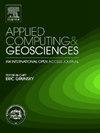Lithological mapping and spectroscopic studies of carbonatite and clinopyroxenite from Hogenakkal carbonatite complex, India
IF 3.2
Q2 COMPUTER SCIENCE, INTERDISCIPLINARY APPLICATIONS
引用次数: 0
Abstract
The Paleoproterozoic Hogenakkal carbonatite complex, situated within the Mettur shear zone, Southern Granulite Terrain, Tamil Nadu, India, is known for its enigmatic carbonatite-clinopyroxenite association and lithology specific rare earth elements (REE) mineralization. The complex comprises two types of carbonatites (silicate-rich carbonatite-I, and silicate-poor carbonatite-II), intruding the clinopyroxenite as isolated pods or ovoid bodies, and are together emplaced within the granulite country rocks. This study employs Landsat 8 multispectral data to map the spatial distribution and extent of the clinopyroxenite dykes. These dykes serve as geological tracers for locating the spatially associated carbonatite bodies. In addition, the present work investigate the spectroscopic properties of REE-bearing carbonatites and clinopyroxenite. Petrography, Raman spectroscopy of minerals, and spectroradiometric measurements of rock samples support the interpretations derived from Principal Component Analysis (PCA), Spectral Angle Mapper (SAM), Support Vector Machine (SVM), Decision Tree, and Random Forest algorithms, thereby aiding in the identification of lithological variations and potential clinopyroxenite occurrences. Carbonatite-II shows more prominent REE absorption features compared to carbonatite-I. This is consistent with petrographic observations and Raman spectroscopy, which show that the REE mineralization in carbonatite-II is dominated by monazite-(Ce) and hydroxylbastnäsite-(Ce), whereas carbonatite-I contains allanite-(Ce) as the primary REE-bearing phase. This study exhibits the efficacy of Landsat series data and non-destructive spectroscopic methods for preliminary mineral exploration and evaluating REE potential before detailed field investigation.
印度Hogenakkal碳酸岩杂岩中碳酸岩和斜辉石岩的岩性填图和光谱研究
古元古代Hogenakkal碳酸盐岩杂岩位于印度泰米尔纳德邦南部麻粒岩地的Mettur剪切带内,以其神秘的碳酸岩-斜辉石岩组合和岩性特异的稀土元素成矿作用而闻名。杂岩包括两种类型的碳酸盐(富硅酸盐碳酸盐i型和贫硅酸盐碳酸盐ii型),以孤立的荚状或卵状体侵入斜辉石岩,并共同侵位于麻粒岩围岩中。利用Landsat 8多光谱数据绘制斜辉石岩岩脉的空间分布和范围。这些岩脉可作为地质示踪剂,用于定位空间关联的碳酸盐岩。此外,本文还研究了含稀土碳酸盐和斜辉石岩的光谱性质。岩石学、矿物拉曼光谱和岩石样品的光谱辐射测量支持主成分分析(PCA)、光谱角度映射器(SAM)、支持向量机(SVM)、决策树和随机森林算法的解释,从而有助于识别岩性变化和潜在斜辉石岩的产状。碳酸盐- ii比碳酸盐- i具有更明显的稀土吸收特征。这与岩石学和拉曼光谱观测结果一致,表明碳酸盐岩ii型中稀土矿化以独居石-(Ce)和hydroxylbastnäsite-(Ce)为主,而碳酸盐岩i型中则以allanite-(Ce)为主要含矿相。本研究展示了Landsat系列数据和非破坏性光谱方法在详细野外调查前的初步矿产勘探和稀土潜力评估中的有效性。
本文章由计算机程序翻译,如有差异,请以英文原文为准。
求助全文
约1分钟内获得全文
求助全文
来源期刊

Applied Computing and Geosciences
Computer Science-General Computer Science
CiteScore
5.50
自引率
0.00%
发文量
23
审稿时长
5 weeks
 求助内容:
求助内容: 应助结果提醒方式:
应助结果提醒方式:


